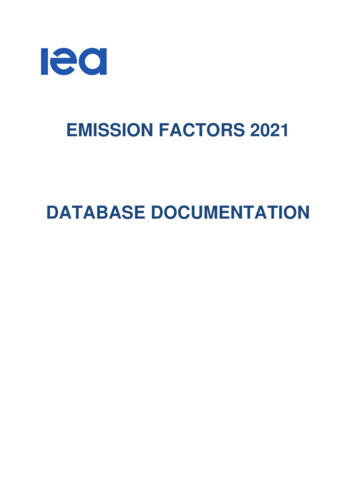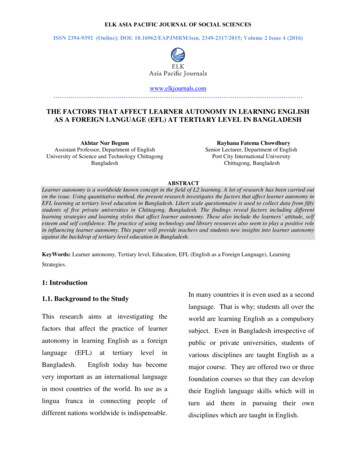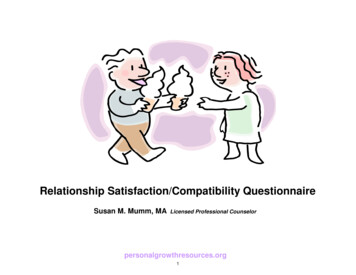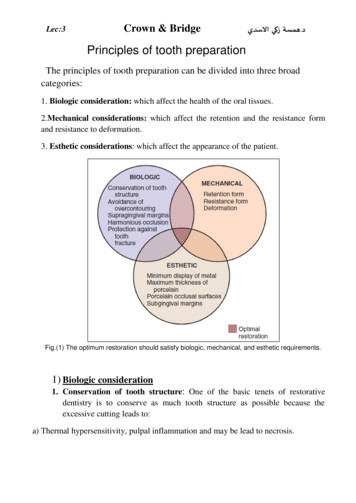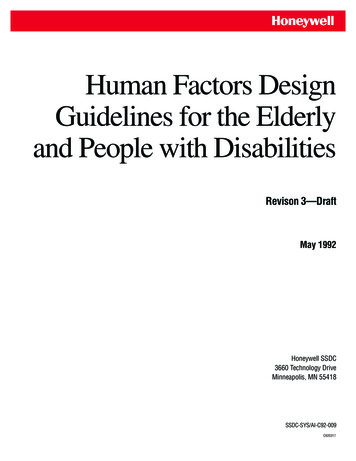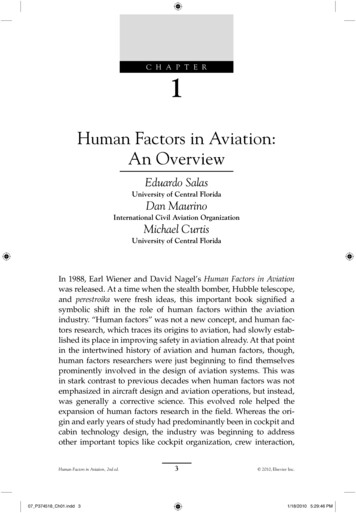
Transcription
FACTORS THAT AFFECT ICT USAGEJournal of Information Technology ManagementISSN #1042-1319A Publication of the Association of ManagementFACTORS THAT AFFECT INFORMATION AND COMMUNICATIONTECHNOLOGY USAGE: A CASE STUDY IN MANAGEMENTEDUCATIONELA GOYALSIES COLLEGE OF MANAGEMENT STUDIES, NAVI MUMBAI, INDIAelagoyal@gmail.comSEEMA PUROHITNM INSTITUTE OF TECHNOLOGY AND DEVELOPMENT, MUMBAI, INDIAsupurohit@gmail.comMANJU BHAGATBIT, MESRA, RANCHI, INDIAmanju bhagat1@yahoo.comABSTRACTInformation and communication technology (ICT) which includes radio, television and newer digital technologysuch as computers and the internet, are potentially powerful tools for extending educational opportunities, formal and nonformal, to one and all. It provides opportunities to deploy innovative teaching methodologies and interesting material thatcreates an interest in students. This study is to determine the critical factors that impact the effective use of ICT inmanagement education from students’ and teachers’ perspective, and to identify the expectations and gaps in its use inmanagement education. A questionnaire-based survey was conducted and the perception of various stakeholders of theimportance of these factors was analyzed. The study was conducted at various management institutes across the city of NaviMumbai. Data analysis revealed that various categories of respondents gave significantly different importance to factorsrelevant for the effective use of ICT. Notably, there was a significant gap between the respondents’ expectations and theactual satisfaction with the current usage of ICT. Certain factors which appeared to be barriers towards ICT usage were alsofound from the analysis. The findings could be useful to any management institution which is thinking of making effectiveuse of ICT in its curriculum.Keywords: ICT, information technology, communication technology, critical factors, management educationINTRODUCTIONInformation and Communication Technologycontinues to be commonly used for global communicationand productivity. Since the earliest use of the World WideWeb for teaching and learning, one of its most powerfulelements has been the ability to engage learners in aninteractive format [3,8]. Schrand [18] suggests the use oftechnology in education has several benefits formotivating students. Schrand further states thattechnology can facilitate more active student learning inthe classroom, and appeal to multiple intelligences, andJournal of Information Technology Management, Volume XXI, Number 4, 201038
FACTORS THAT AFFECT ICT USAGEdifferent learning styles. Jonassen, Howland, Marra andCrismond [9] state that technology can be only effectivein the learning process when it meets a learningrequirement. Access to technology related multimedia haspreviously been shown [1] to improve cognitiveengagement and cognitive absorption in users. Greatexpectations have emerged for technological advances tomeet society’s demands in new way. Many universitiesand private corporations are investing significant capitalin e-learning systems [13]. A variety of these highereducation institutions are driven by an enormous increasein the global demand for higher education, which providesnew opportunities to contribute to the educational process.However, as many projects such as the UK eUniversity, NYU Online, Scottish Knowledge,Universities 21 and Global University Alliance (GUA),which all developed around e-learning applications, havefailed to realize their aims and goals, leading many toquestion the quality and capabilities of this form ofeducation. Full understanding of the factors contributingto effectiveness of e-learning systems will help EUniversities and institutions channel funding to effectivefactors and redesign or eliminate non-effective factors(Levy, 2006).In this paper we are not restricting to only elearning, but widening the scope to include the gies that are or can be used in education. Criticalfactors can be viewed as those activities and constituentsthat must be addressed in order to ensure its successfulaccomplishment and acceptance by the variousstakeholders. This is an empirical study to find out whatwould make ICT usage in management educationeffective from the students and teachers perspective.LITERATURE REVIEWA broad range of factors that can influence theuse of technology in learning has been mentioned in theliterature. Successful implementation of ICT change is notabout equipment or software but influencing andempowering teachers; it is not about acquiring computerskills but supporting teachers in the ongoing engagementwith students in their learnings [21]. A study wasconducted by Neset Hikmet, Eileen Z. Taylor andChristopher J. Davis [14] in 2008 in US. They concludedthat before investing heavily in ICT, school administratorsshould appreciate that the nature of ‘productivity’ inlearning is elusive. Their study provided some wellreasoned empirical evidence that highlights that thespecific needs and expectations of students, teachers,parents and administrators who adopt ICT for use ineducation should be studied as the outcomes ofinvestments in ICT are uncertain and may not alwaysalign with the intentions of school administrators. Anotherstudy conducted by Michael Laff [11] in Princeton in2007 compared the learning preferences of ITprofessionals with professionals from other sectors andfound that while training professionals in other fields arewrestling with the best way to offer active learning in thedigital age, intensive classroom curriculums are stillwidely available for IT professionals. Online training,blended learning and other upstart methods may be thefuture as many organizations move away from traditionalclassroom instruction, but in the IT field, instructor- ledtraining remains the preferred method for manyapplications. The study says the ideal way to offerblended learning to IT workers would be four weeks ofclassroom instruction with participant interaction and thenfour weeks participants working on their own to buildskills and learn techniques. Study conducted by NorShariza Abdul Karim[15] (Malaysia) and RobertHeckman(USA) in 2005 said that “The learning industryis undergoing a transformation process through the use ofinnovative products and tools from the ICT revolution.However it is important that the tools are evaluated forappropriateness, effectiveness and usability from theuser’s point of view. This understanding can assisteducators in choosing the best product and in managingthe tools for optimum benefit.” They investigated groupcommunication media choice and the use of a web-basedlearning tool, as well as other types of communicationmedia such as email, telephone and face-to-face, forcommunication and collaboration to complete given tasks.The study conducted by Phil Banyard and JeanUnderwood in 2007 [2] captured teachers’ perceptions ofsupport for and attitudes towards use of ICT in theirschool and also the degree to which they were encouragedand had responded to the personalisation of teaching andlearning. The result showed that while teachers werepositive about both the personalisation agenda and therole of ICT in delivering that agenda, there weresignificant inter-subject differences with mathematicsteachers seeing the least value of the personalisationpolicy and design and technology teachers beingunconvinced by the value of ICT. Another studyconducted in UK in 2004 by Gordan Graham [6] says thatbefore using or discarding any technology, the followingquestions should be answered: What is the anticipatedbenefit of the innovation and will it be genuinelyadditional benefit? Is the chance of it being implementedsuccessfully higher than the chance of its failure? What isthe cost of its introduction in terms of disruption to theexisting systems that are tried, known and reliable? Arethere recurrent patterns of behavior that would give somepointers to its likely reception?Journal of Information Technology Management, Volume XXI, Number 4, 201039
FACTORS THAT AFFECT ICT USAGEBased on the insights obtained from the study byThe Institute for Higher Education Policy in 2000, the keyfactors for successful e-learning environments are arning Process, Course Structure, StudentSupport, Faculty Support, Evaluation and Assessment.According to Papp’s study [17] e-learning critical successfactors included intellectual property rights, suitability ofthe course for e-learning environment, building the elearning course, e-learning course content, e-learningcourse maintenance, e-learning platform, and measuringthe success of an e-learning course. He suggestedstudying each one of these imperative factors in isolationand as a composite to determine which factor(s) influenceand affect e-learning success. Thierry Volery [20], basedon an empirical study among college students, suggested aframework for the critical success factors in onlineeducation, focusing on three aspects in e-learning Technology (ease of access and navigation, interfacedesign and level of interaction), the instructor (attitudestowards students, instructor technical competence andclassroom interaction) and the previous use of thetechnology from a student's perspective or studentsprevious computer knowledge. Soong, Chan, Chua, andLoh [19] using a multiple case study, verified that the elearning critical success factors are: human factors,technical competency of both instructor and student, elearning mindset of both instructor and student, level ofcollaboration, and information technology infrastructure.They recommended that all these factors should beconsidered in a holistic fashion by e-learning adopters.Graf and Caines [5] in “WebCT Exemplary CourseProject” developed a scoring rubric to evaluate onlinecourses. They presented criteria in two categories:academic rigor (10 items) and content robustness (6items). Academic rigor includes items such as courseobjectives, assignments, student participation, use oftechnology, course content, and ancillary resources.Content robustness refers to the degree to which thecourse content is available online, how it is structured, theuse of images and graphics, the degree of interactionamong students and with the lecturer and the type andquality of student assessment. Oliver [16], in “Assuringthe Quality of Online Learning in Australian HigherEducation”, addresses the major issues confronting thesuccessful adoption and sustained use of e- learning inAustralian higher education context. Factors to supportand sustain quality in e-learning programs are: Teacherexpertise in online teaching, Student readiness to moveonline, Technology infrastructure, Provision of contentand learning resources, Instructional design. In an attemptto provide a pedagogical foundation as a prerequisite forsuccessful e-learning implementation, Govindasamy [7]discussed seven e-learning critical factorsnamely,institutional support, course development, teaching andlearning, course structure, student support, facultysupport, and evaluation and assessment. Fresen [4] in aninclusive study highlighted six critical success factors inhis ucture, Student advice and consultation,Institutional evaluation of the program effectiveness),Technology factors (Reliability, 24X7 availability,Technical support for lecturers and students, Systemtraining for lecturers and students, appropriate use ta), Lecturer factors (Interaction with students,Frequent and constructive feedback to students,qualifications, professional development), Student factors(Communication with fellow students, Time management,Learner control over time, place, pace of learning,Expectations of efficiency and effectiveness, Employcritical thinking strategies, Motivation/commitment/selfesteem, Improve problem-solving abilities), Instructionaldesign factors (Group learning, Student engagement inhigher cognitive levels, Rich learning resources, Activelearning, Enhanced student motivation, Design standards,Manageable segments, Including social, cultural, gender,disabilities, Routine review and evaluation of courses,Purposeful use of learning media, Minimize studentfrustration, Appropriate use of images, graphics, Offer acomplete learning package, Appropriate layout andpresentation, Appropriate bandwidth and downloaddemands), Pedagogical factors (Offer multiple paths onment, Students instructed in proper researchmethodology, Relevance and accuracy of content,Currency of learning resources and content, Research andcontinuous improvement).Khan [10] identified various critical factors forsuccessful e-learning. He clustered critical success factorsin the following categories- Institutional factors includeassessment, financial readiness, infrastructure readiness,cultural readiness and content readiness; Managementfactors include management team, managing contentdevelopment process, and managing delivery andmaintenance.Technological factors cover infrastructureplanning, hardware, and software; Pedagogical factorsinclude content analysis, audience analysis, goal analysis,medium analysis, design approach, organization andlearning strategies; Ethical factors comprise social andpolitical influence, cultural, diversity, bias, geographicaldiversity, learner diversity, digital divide, etiquette andlegal issues; Interface design factors include page and sitedesign, content design, navigation, accessibility, usabilityJournal of Information Technology Management, Volume XXI, Number 4, 201040
FACTORS THAT AFFECT ICT USAGEtesting, resource support, online support, online resourcesand offline resources; Evaluation factors includeevaluation of content development process, evaluation ofe-learning environment, evaluation of e-learning at theprogram and institutional levels, assessment of learners.RESEARCH OBJECTIVESThe study has the following objectives:1. To determine, from literature, the critical factorswhich have impact on the effective use of ICTin management education.2. To determine which factors, among many, aregiven more importance by students andteachers.3. To determine the satisfaction level, amongstudents and teachers, with the current usage ofICT in their institution.4. To identify the gaps in the expectation and actualsatisfaction levels in the use ofICT inmanagement education.5. To determine the difference in perception ofrespondents based on stakeholder (teacherstudent), undergraduate degree, institute/collegeand post graduate specialization, in terms of theimportance they give to the various factors andsatisfaction from the current usage in theirinstitutes.RESEARCH METHODOLOGY ANDRESEARCH HYPOTHESISA questionnaire based survey was conducted at amanagement institution in a metropolitan city of India.The respondents were students and teachers of thisinstitution. The questionnaire had a list of factors that arerelevant for ICT usage in education. These factors werefound out after a thorough literature review.The questionnaire was divided in three parts – inthe first part the respondent was asked to fill in thedemographic details. In the second part the respondentwas asked to fill, using Likert scale (rating 1-5), howmuch importance they gave to each of the specifiedfactors. In the last part of the questionnaire, therespondent was asked to fill in their satisfaction level, ona scale of 1-5, for the current ICT usage in their institutionbased on the same factors.Besides the above give objectives, the followinghypothesis would also be tested:H10: There is no significant difference in the perception ofrespondents on the importance given by them to thevarious factors based on their undergraduate backgroundsuch as Science, Arts, Commerce, BBA/BMS,Engineering, BCA, LLB and Medical.H20: There is no significant difference in the perception ofrespondents on the importance given by them to thevarious factors based on their PG specialization such asHR, Marketing, Finance, Systems, Biotech andOperations.H30: There is no significant difference in the perception ofrespondents on the importance given by them to thevarious factors based on their PG college.ANALYSISCollecting information from all these studies, anextensive list of critical factors for successful ICTimplementation was arrived at. There were 35 factors thatcan affect the use and 20 outcomes of using ICT as givenbelow:The questionnaire was administered to 458respondents from 5 colleges. It included 57 teachers and401 students from different streams of management suchas HR, Marketing, Finance, Biotechnology, systems andoperations. In the first section, respondents were asked tofill in their names, age group, gender, educationalqualifications and specialization. The second section hada list of factors that would affect the use of ICT inmanagement education. The respondents were requestedto rate these factors on a scale of 1-5 (Likert scale) with 1for not at all important, 2 for not important, 3 for neutral,4 for important and 5 for very important. In this section,the outcomes of using ICT were also listed and therespondents were asked to rate these as per theirimportance starting with 1 for not at all important andgoing to 5 for very important (Likert scale). In the thirdsection, the factors and outcomes were listed again. Here,the respondents were asked their satisfaction level forthese factors and outcomes for the current usage of ICT intheir institute. The rating was done using Likert scale of1-5 with 1 being not at all satisfied and 5 being highlysatisfied. SPSS was used for data analysis.The respondents were asked to rate these factorsfor their importance. Mean for the importance of each ofthese factors, as given by the respondents, was calculated.The respondents were also asked to rate these factors forsatisfaction with the current usage in their institutes. Meanof satisfaction was also calculated. The differencebetween the importance given and the satisfaction wasthen calculated. The values obtained are shown in Table1.Journal of Information Technology Management, Volume XXI, Number 4, 201041
FACTORS THAT AFFECT ICT USAGEInstitutional Factors:ICT being a part of the organization’s work culture,Infrastructural readiness of the institute, Cultural readiness ofthe institute, Financial readiness of the institute, Mandatoryinstitutional requirement for all students and teachers to takebasic technology courses, All courses at the institute to havea course website, ICT integration into classrooms to be anorganizational policy, Intranet site of the institution,Availability of a National Government Policy to implementICT in the institute, Policy to evaluate the effectiveness ofthe ICT use, Building awareness towards importance oftechnology,Pedagogical Factors:Technology being a part of daily routine,Keeping up with current developments inICT, Adaptability of the course to beingtaught through ICT, Availability ofeducational software, Time required to learnthe use of technology, Ease of navigation ofthe course content through an ICT deviceTeacher Factors:Teacher’s attitude towards use of technology,Teacher’s technical competence, In-class trainingprovided by faculty for ICT that they are using inclass, Availability of specialized IT teachers,Providing encouragement to teachers to usetechnology in their teaching more often,Upgrading teacher’s ICT skills, Teacher’sconfidence in using ICT, Teacher’s academicqualificationsCriticalSuccessFactors forICT useTechnological Factors:Reliability(i.e should do as expected of it) ofICT, Ease of availability of ICT, Time toupload and download, Availability of resourcesto promote ICT usage, Providing libraryreserves electronically, Technical Support touse ICT at the institutional level, Mandatorytechnology courses such as MIS/HRIS for allstudents/teachers, IT and data securityCriticalOutcomes of ICTConvenience (Time and place), Better collaboration using online discussion boards, Improving communicationbetween students and teachers, Improvement in understanding of complex or abstract concepts, Moreopportunities for practice and reinforcement, Improve overall learning, Doing course activities more conveniently,More focus on real world tasks and examples, Greater control of class activities, Increased motivation towardslearning, reduction in time taken to complete the task, increase in productivity, increase in quality of projects,group learning, active learning, make the work more interesting, improving the presentation of the subject, developthe power to think, improvement in student grades, reducing the cost of educationFigure 1: Factors and outcomes that would affect ICT usageJournal of Information Technology Management, Volume XXI, Number 4, 201042
FACTORS THAT AFFECT ICT USAGETable 1: Difference of mean of importance and mean of satisfaction for all factors/outcomes, given tothem by the various stakeholders (sorted in descending order of importance)FactorTime to upload and download (speed)Mean(µe)Mean(µs)Mean(µs) - Mean(µe)3.562.44-1.12Ease of availability of ICT3.522.55-0.97Reliability (i.e. should do as expected of it) of ICT3.462.54-0.92Increase in quality of projects3.452.7-0.75Convenience (time and place)3.442.61-0.83Increase in efficiency3.432.65-0.78Improving the presentation of the subject.3.423.412.872.66-0.55-0.75Improving communication between students and teachersIncrease in productivity3.412.7-0.71Teacher’s technical competence3.42.62-0.78Make the work more interesting3.42.75-0.65IT and data security3.392.65-0.74More focus on real-world tasks and examples.3.392.68-0.71Improve overall learning.3.392.7-0.69Upgrading teacher’s ICT skills3.382.57-0.81Availability of specialized IT teachers3.372.62-0.75Providing students more opportunities to use technologyin their coursework.Allow active learning3.362.63-0.733.362.75-0.61Infrastructural readiness of the institute to support ICTAvailability of Educational lop the power to think3.332.7-0.63Ease of learning technology.3.322.63-0.69Improvement in understanding of complex or abstractconcepts.More opportunities for practice and reinforcement.3.312.51-0.83.312.58-0.73ICT being a part of the organization’s work culture3.312.63-0.68Financial readiness of the institute to support ICTKeeping up with current developments in ICT.3.32.53-0.77Reducing the cost of education3.32.66-0.64Intranet site of the institution3.292.53-0.76Technical support to use ICT at the institutional level3.272.48-0.79Ease of navigation of the course content through an ICTdeviceAdaptability of the course to being taught through -0.59Providing encouragement to teachers to use technologyin their teaching more often.Building awareness towards importance of TechnologyJournal of Information Technology Management, Volume XXI, Number 4, 201043
FACTORS THAT AFFECT ICT USAGETable 1 (continued)FactorImprove group learningMean(µe)Mean(µs)Mean(µs) - Mean(µe)3.252.73-0.52Availability of resources to promote ICT usage3.242.5-0.74Increased motivation towards learning3.242.63-0.613.232.49-0.74Better collaboration among teachers using onlinediscussion boardsMandatory institutional requirement for all students andteachers to take basic technology courses.3.232.55-0.68Technology being be a part of daily routine3.222.76-0.46In-class training provided by the faculty for ICT they areusing in class.Providing library reserves t in student grades3.22.66-0.54Greater control of class activities3.172.6-0.57All courses at the institute to have a course website.3.122.32-0.8Cultural readiness of the institute to support ICT3.122.53-0.59ICT integration into classrooms to be an organizationalpolicyPolicy to evaluate the effectiveness of the ICT use3.032.52-0.513.022.43-0.59Mandatory technology courses such as MIS, HRIS for allstudents/teachers32.45-0.55Use by peers2.972.62-0.35Availability of a National Government Policy toimplement ICT in the institute2.892.35-0.54The following can be seen from the table:1. All the factors/outcomes that were found to beimportant for ICT usage were not given equalimportance by the stakeholders. Some of thefactors/outcomes were given a lot of importancewhile others were given less importance. Themean value for importance varies from 3.56 to2.89.2. The satisfaction levels were lower than theexpectations for all the factors and outcomes.So, the stakeholders were, in general, notsatisfied with the way ICT is being currentlyused in their institute. The mean value forsatisfaction varies from 2.87 to 2.32.3. There is a large gap between the importancegiven by the stakeholders and their satisfactionfrom the current usage. There is a hugemismatch between what the stakeholders wantand what they are currently getting. Thedifference between the mean for importance andthe mean for satisfaction varies from -1.12 to 0.35.4. The following factors could be considered asbarriers for ICT usage and hence the satisfactionlevels are very low for them. These are “Allcourses at the institute to have a coursewebsite”, “Availability of a NationalGovernment Policy to implement ICT in nically”, “Policy to evaluate theeffectiveness of the ICT use”, “Time to uploadand download (speed)”, “Mandatory technologycourses such as MIS, HRIS for allstudents/teachers”, “Technical support to useICT at the institutional level”, “Bettercollaboration among teachers using onlinediscussion boards”, “Availability of resources topromote ICT usage”, “Financial readiness of theinstitute to support ICT” and “Improvement inunderstanding of complex or abstract concepts”.Journal of Information Technology Management, Volume XXI, Number 4, 201044
FACTORS THAT AFFECT ICT USAGEFrom Tables 2 and 3 we can see that the mostimportant factors and outcomes of using ICT in themanagement education process are different for teachersand students.Also the most important factors and outcomes ofusing ICT in the management education process aredifferent for stakeholders from difference streams. omes for stakeholders from finance,marketing, HR, biotech and systems.Table 3: Top 15 factors/outcomes of using ICTas given by students( based on mean)Factor/OutcomeTime to upload and download (speed)Ease of availability of ICTReliability (i.e. should do as expected of it) of ICTIncrease in quality of projectsConvenience (time and place)Table 2: Top 15 factors/outcomes of using ICTas given by teachers (based on mean)Factor/OutcomeIncrease in efficiencyIncrease in productivityImproving the presentation of the subject.Make the work more interestingEase of availability of ICTUpgrading teacher’s ICT skillsMore focus on real-world tasks and examples.Teacher’s technical competenceConvenience (time and place)Time to upload and download (speed)Improving communication between students andteachersReliability (i.e. should do as expected of it) of ICTIT and data securityImproving communication between students andteachersIT and data securityImprove overall learning.Providing students more opportunities to usetechnology in their coursework.Availability of specialized IT teachersAvailability of Educational softwareImproving the presentation of the subject.Ease of navigation of the course content through anICT deviceImprove overall learning.Providing encouragement to teachers to use technologyin their teaching more often.Increase in efficiencyIncrease in quality of projectsTable 4: Top 5 factors/outcomes of using ICTas given by finance stakeholdersFactor/OutcomeMake the work more interestingIncrease in quality of projectsImproving communication between students andteachersInfrastructural readiness of the institute to support ICTIncrease in productivityTable 5: Top 5 factors/outcomes of using ICTas given by marketing stakeholdersFactor/OutcomeIncrease in efficiencyImproving the presentation of the subject.Increase in quality of projectsIT and data securityIncrease in productivityJournal of Information Technology Management, Volume XXI, Number 4, 201045
FACTORS THAT AFFECT ICT USAGETable 6: Top 5 factors/outcomes of using ICTas given by HR stakeholdersFactor/OutcomeConvenience (time and place)Upgrading teacher’s ICT skillsImproving the presentation of the subject.Financial readiness of the institute to support ICTIncrease in efficiencyTable 7: Top 5 factors/outcomes of using ICT asgiven by Operations stakeholdersFactor/OutcomeEase of learning technology.More focus on real-world tasks and examples.Keeping up with current developments in ICT.Availability of Educational softwareImproving communication between students andteachersTable 8: Top 5 factors/outcomes of using ICT asgiven by Biotech stakeholdersFactor/OutcomeIncrease in efficiencyMore opportunities for practice and reinforcement.There is no significant difference in theperception of stakeholders belonging to different PGspecializations (HR, marketing, finance, Biotech,Operations, systems and others) for the top 10 factors(Table 10).When the comparison was done for all thefactors, the following factors showed significantdifference:“Policy to evaluate the effectiveness of the ICTuse” - HR people had different opinion on this ascompared to other streams. The mean importance to thisfactor given by HR people was 3.54 whereas all otherstreams had given lower value to the importance(Marketing: 2.93, finance: 3.11, Operations: 2.67,Systems: 2.50, Others:2.89, Biotech: 3.30).“Financial readiness of the institute to supportICT” – For this factor the opinion was varied acrossstreams, like Finance and Marketing (means: 3.46 and3.24), HR and Biotech (means: 3.65 and 3.22), HR andMarketing (means: 3.65 and 3.24).“Infrastructural readiness of the instit
TECHNOLOGY USAGE: A CASE STUDY IN MANAGEMENT EDUCATION ELA GOYAL SIES COLLEGE OF MANAGEMENT STUDIES, NAVI MUMBAI, INDIA elagoyal@gmail.com . University, NYU Online, Scottish Knowledge, Universities 21 and Global University Alliance (GUA), which all developed around e-learning applications, have failed to realize their aims and goals, leading .



